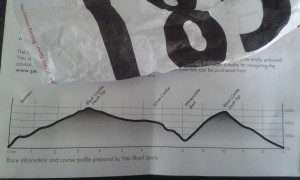
Black Combe race number and profile
On Saturday Emma and I travelled up to take part in the Black Combe fell race (Emma in a spectating capacity) on the very edge of the South-Western Lakes. Having previously done this in 2012 I’d pencilled this in hoping to be more prepared than I was back then. Sadly I was not.
The race is an absolute cracker and a brief description will hopefully set the scene. The race starts almost at sea level near the village of Silecroft and after a gentle start you really get stuck into the steep climb of Seaness, then a brief levelling before continuing the climb to the North Summit – there’s a North and, 13 metres lower, South Summit – of Black Combe from where you traverse round steep crags and screes to the lighter sounding White Combe. The sting in the tail is the climb from the beck at the bottom of White Combe to the aforementioned South Summit of Black Combe, before descending the main path back to the bottom.
Some stats: The race is 13 km with a total climb of 1000 metres. The course records are 1:05:18 (male) and 1:18:49 (female).
For me, after a steady enough start I felt okay going into the first climb. Described elsewhere as “hands on knees” I find this climb more a grassy scramble with hands on the ground rather than knees, but then I haven’t got the finely honed climbing skills (or descending skills – more on that later) of the Lakeland fellrunner. I then set about the task of tapping up the well manicured main path to the ultimate summit. This is the bit of the race I was most pleased about. On a clear day, and it was thankfully clear, the horseshoe traverse from the summit slowly reveals an amazing view down the valley with the Irish Sea as a backdrop.
From the White Combe summit things started to go wrong. I seem to have lost my nerve on descending even steady-away descents and was caught by a few runners on this part. I’d prepared myself (given my lack of preparation) for ‘going backwards’ on the climb to Black Combe’s South summit and so it proved, though on reflection not the worst part of the race. The climb, to offer some sort of insight, begins with maybe a quarter of the total climb in sight (this isn’t a measured distance but an estimation using an oxygen starved mind). There are about 2 or 3 more of these ‘false’ summits although the rim of the screes and crags to the right never lets you forget how much higher you have to climb. Eventually the gradient eases but the pain in your legs, back and mind doesn’t!
The worst part of the race for me, peculiarly, was the final descent. At times steep but never threateningly so it begins, for the adventurous or sheep (I fall into the latter category), with a straight-line route through heather and tussocks before picking up the easier main path. This ‘proper’ running reduced me to a run which was barely faster than a walk. It’s worth remembering this was going DOWNhill. Runners were streaming past me at this point. All will have taken note of my sorry descent, legs buckling with almost every stride.
Suffice to say the finish was a very welcome sight, and the pie and hot drink in the Village Hall afterwards were a godsend.
It is THE best fell race I’ve ever done (although in my fledgling fell running career I don’t have a huge mass of evidence to challenge this claim). Any recommendation comes with a health warning which is as much mental as it is physical, especially for the second climb.
In the final analysis I was 98th in 1 Hour 36 Minutes and 36 seconds, some 27 minutes 42 seconds behind the winner, Rob Jebb.
Joel

